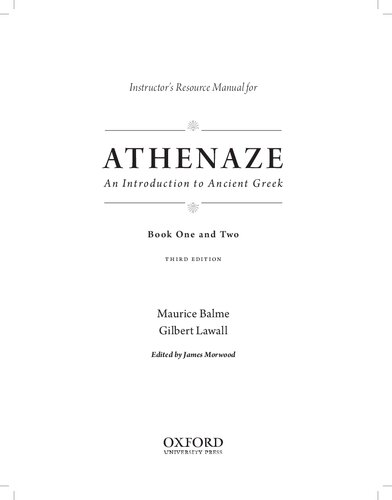

Most ebook files are in PDF format, so you can easily read them using various software such as Foxit Reader or directly on the Google Chrome browser.
Some ebook files are released by publishers in other formats such as .awz, .mobi, .epub, .fb2, etc. You may need to install specific software to read these formats on mobile/PC, such as Calibre.
Please read the tutorial at this link: https://ebookbell.com/faq
We offer FREE conversion to the popular formats you request; however, this may take some time. Therefore, right after payment, please email us, and we will try to provide the service as quickly as possible.
For some exceptional file formats or broken links (if any), please refrain from opening any disputes. Instead, email us first, and we will try to assist within a maximum of 6 hours.
EbookBell Team

0.0
0 reviewsThis course was written for use in schools, colleges, and universities with students who have not necessarily been exposed to any other highly inflected language. The course aims at teaching students toread and understand Greek within the context of fifth-century Greek civilization and culture. All elements in the course are meant to contribute to this end.
The readings form a continuous story with interwoven subplots. In Chapters 1–20 the narrative consists of made-up Greek, a good part of it based on Homer and Herodotus; in Chapter 21 and the following chapters dependence on ancient sources — Thucydides, Plato, Herodotus, Bacchylides, and Aristophanes — increases steadily. The main narrative of each chapter is divided into two parts. Before each narrative is a list of words to be learned. The inductive method (see below) involves quickly reading the lists through before starting on the narrative, and then learning them thoroughly after the narrative has been completed, when the vocabulary has been encountered in context and will thus prove easier to memorize. Some teachers, however, will feel that the lists should be learned in advance of the readings. Following each narrative is an explanation of the major new grammar and syntax that have occurred in the reading. Exercises then give practice with the new linguistic features. In the middle of each chapter is a short essay providing the historical and cultural context of the narrative. Reading passages at the end of each chapter are offered for comprehension; they either continue the narrative or form subplots, drawn from Homer’s Odyssey, Herodotus, and Thucydides. Chapters 29 and 30 at the end of Book II are devoted primarily to passages from Thucydides and Aristophanes, the Greek of which has not been changed from the original, except for some omissions.